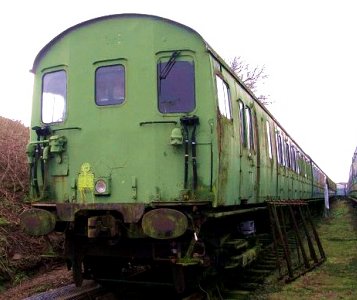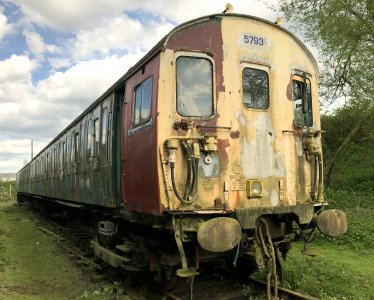 Established 1996
Established 1996
Suburban Electric Railway Association
Support Your Local Train
South Tyneside EPB Unit
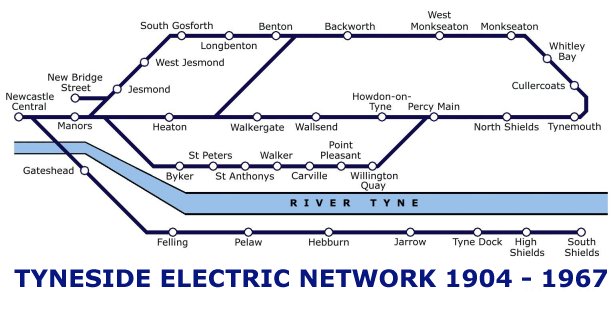
The Tyneside Electrics
The North Eastern Railway were faced with a dilemma in the first years of the 20th Century. The suburban traffic around Newcastle Central which was a reliable source of income was being eroded by stiff competition from newly electrified tramways. In 1902 receipts for the area dropped by 57%. The NER called upon the services of consulting engineers Charles Mertz and William McLellan to advise them of the extent of the problem and their possible options on how best to meet the challenge of the electric tramcar. The report the NER received advised them that they needed to offer a regular clock face timetable that could be flexible to the demands of the local traffic, steam trains were not able to offer this so they recommended electrification of the suburban routes on the north side of the river. The NER opted for a third rail system and the first services ran in March 1904 between New Bridge Street and Benton. The electrified network was extended over the year and eventually formed a loop around the coast via Whitley Bay and back to Newcastle Central via Heaton and the Riverside loop line via Carville. By 1915 the New Bridge Street terminus was closed and the services all started and terminated at Newcastle Central.
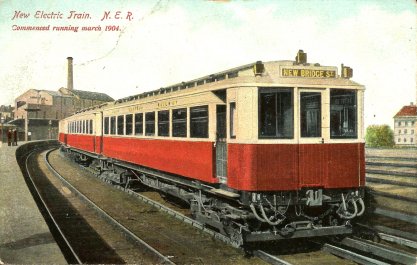
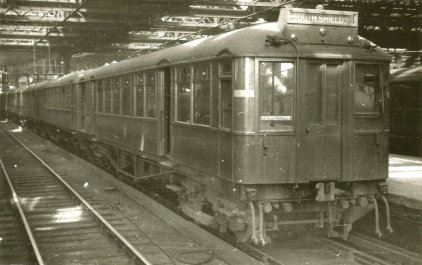
Under the LNER the network was expanded in May 1938 when the 'South Tyneside' line from Newcastle to South Shields was electrified. Initially the service used 1920 built units from the NER that were refurbished and these lasted until 1954 when new stock was required to replace them. This stock was procured under the British Railways standard Mark 1 suburban build scheme and was laid out to meet the needs of rapid loading and unloading of commuter trains, with doors to every seating bay and the stock was non-gangwayed and featured a mix of full width compartments and semi-saloons. The fifteen units built for the South Tyneside route were suburban type carriages and were an add on for a fleet of 79 units being built for service on the commuter routes from London to North Kent. Each unit consisted of two coaches, the driving motor brake and a driving trailer composite and were built by the former Southern Railway carriage works at Eastleigh.
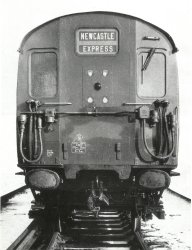
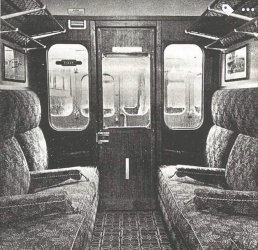
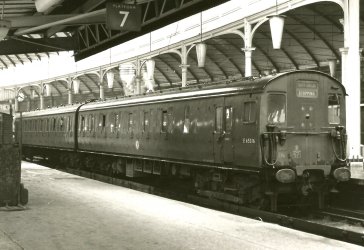
The bodies of each vehicle were 63 feet 11 and a half inches long and sat on an all steel frame. The body and underframe made extensive use of welded construction. Single bolster bogies using riveted sub assemblies were provided with 3 foot 6 inch diameter wheels for the trailers and 3 foot 4 inch wheels on the single motor bogie, this was mounted under the guard and luggage van end of the unit and featured two 250hp English Electric EE507 traction motors. Between the bogies of the driving motor brake car and mounted to the underframe were the various boxes containing the electro-pneumatic contactors for control of the traction and heating as well as the Westinghouse DH25 air compressor. A battery box was also provided with cells arranged to give a 70v DC output to power the control and emergency lighting, however these batteries could not power the train's motors or heating. Under normal running conditions the heating, which was mounted in the spaces beneath the seats was fed from the third rail supply. The lighting was powered by the 70v DC output of a motor-generator set that was also mounted on the underframe of the motor car and ran constantly if the unit was connected to a live third rail. Above the floor seating was provided for 74 third class passengers in the driving motor brake and 90 third class and 8 first class in the driving trailer composite. The provision of a single first class compartment was the first variation on the Tyneside units from those built for the Southern Region. The guards brake was the next big difference between the units built for Tyneside and those for service in the south. The need to convey boxes of fish, prams, parcels and other luggage on the South Shields route called for a much larger luggage space, over 15 feet long. At the rear of which, the opposite end to the driving cab the guard was provided with a swivelling bucket seat and two periscope lookouts, one for each direction of travel. The final physical difference from the Southern Region units was the provision of the headcode lights and destination blinds on each cab front between the windows. At driver's eye height level was the cluster of four white lights with a red tail lamp in the centre. The Tyneside units had a top speed of 90mph as opposed to the 75mph of the Southern Region version although when they had a chance to go this fast on the Tyneside network is a mystery.
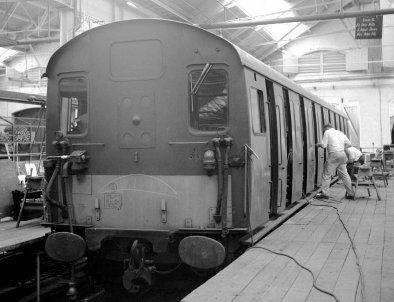
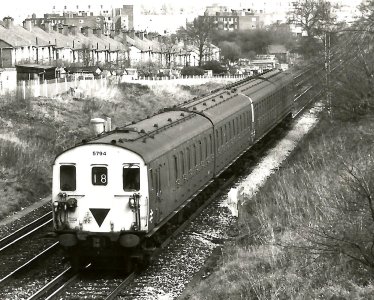
The units lasted in the north east until the South Shields line was de-electrified in January 1963. They were then all transferred to the Southern Region, passing through Eastleigh works where the Tyneside headcode lights and blinds were removed and replaced with a two digit SR one, smaller than those fitted to EPB units built for the Southern. The first class compartment was declassified and the bogies were changed to 75mph ones. The long brake van remained and it was this along with the smaller headcode box that made an ex-Tyneside unit easy to spot. The units lasted in passenger service until laid aside in 1985. Many saw further use in departmental service and the last example was not withdrawn until 2005.
Our Unit
The preserved unit is a correct formation British Railways built South Tyneside 2-EPB. It is formed of a driving motor brake (DMB) and a driving trailer composite (DTC) but the two preserved vehicles never ran coupled together on Tyneside, indeed they never ran together as a complete unit in passenger service in any period of their life; the joining of these two vehicles happened during departmental service.The DMB was from the eleventh of the 15 units built, it was released from Eastleigh Works on March 2nd 1955 and added to NE Region stock on April 2nd 1955, it carried the running number of 65321. The DTC was from the thirteenth built set and carried the number 77112, being released from Eastleigh Works on March 23rd 1955 and added to NE Region stock during the second half of April. Both units performed the usual duties whilst based at South Gosforth and were displaced in January 1963. The unit containing our DMB was accepted on the Southern Region during August 1963 which was after the unit with our DTC, which the Southern had accepted the month before.
The units had carried no unit numbers on Tyneside so these were allocated and applied using the Southern Region four digit system at the end of the sequence that contained the 2-EPBs that had been built for that region, the ex NE units became 5781 – 5795 with the unit numbers carried at the upper centre of the cab fronts, our DMB was in unit 5791 which was released to Southern Region service on October 8th 1963 and the DTC (now a DTS) was in unit 5793 which joined the service fleet on an unknown date during September / October 1963. Coach numbers remained the same as they had done since they were built with the exception of the E prefix which was replaced by a S as they were 'Southern' units now. The conversion work took just under two months to complete for each unit and they were then accepted at their new home depot of Wimbledon Park on the South Western Division of the Southern Region. The TOPS system was introduced during the late 1960s and covered EMUs too, initially the 2-EPBs were class 413 but this was changed in 1975 to class 416 and eventually to 416/2. During their lives starting bells, loudaphone cab-cab communication equipment and AWS were all fitted. Our unit had coaches that were fitted with different types of AWS, the DTS of 5793 had the older 'Baldwin' system but the DMB was one of the last units fitted out with AWS so got the later 'Simplified' system. Exams and maintenance would be carried out at both Wimbledon Park and Selhurst depots. A few months before being withdrawn from service in 1985 unit 5791 was renumbered to 6291 and 5793 became 6293.
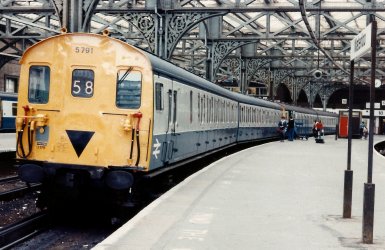
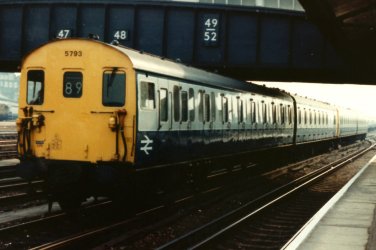
6291 and 6293 got the call to work for the engineering team concerned with the electrification of the Tonbridge to Hastings line. They both moved from Eastleigh to Strawberry Hill in October 1985 and underwent a bogie swap with 2-HAP units 6007 and 6008. This re-instated their 90mph express gear ratio capability. The units were renumbered into the Southern's three digit sequence for departmental stock; 6291 became 053 and 6293 became 054, the coaches were renumbered into the ADB sequence with our DMB 65321 becoming ADB977505 and out DTS becoming ADB977508. The two units were put to work on test trains, including the first electric train to travel the length of the Tonbridge to Hastings line under electric power. Included in the test train formation was a test coach called MARS that had been converted from a class 501 emu and was used to test both alignment and integrity of the newly installed electrification, also included was a class 73 locomotive to provide back up traction power from its diesel engine if there was a problem with the third rail traction supply. The cab of 053's DMB was fitted with push buttons and the associated wiring to enable it to start the engine of the 73 by remote control. The DMB of 054 was similarly treated as it was these two cabs that were always at the front and rear of the test train formation. The electrification work was completed early in 1986 and the two units were returned to Strawberry Hill depot only to be pressed back into action during August the following year on test trains connected with the electrification of the line between Sanderstead and East Grinstead. 053 was modified further in October 1988 to be fitted with a small sandite hopper. This meant the former passenger saloon was stripped of all its seating and a doorway was cut into the bulkhead between the passenger brake and the saloon area whilst the bulkhead to the rear saloon of the vehicle was completely removed with all the seating from the interior stripped thus making the passenger area now an empty space. The guards position was retained but the sandite hopper (smaller than those used for dedicated sandite units) was installed in the former saloon along with the associated pumps and control equipment with delivery pipes passing through the floor to the trailer bogie of the vehicle. It was in this guise that the unit was used during by the rolling stock department on adhesion trails on the Shepperton branch from Strawberry Hill depot during October 1988 and again involving class 442 units between Brookwood and Basingstoke the following April. It was sometime around 1990 that the formation of 053 was changed to the formation that ended up becoming the preserved unit. No one is quite sure when it happened, why or how. It is likely that the formation was changed at Strawberry Hill depot as both 053 and 054 were based there when not needed for engineering traffic. They had certainly been used during May and September 1989 as tractor units in formations with 1938 tube stock that were being taken from Strawberry Hill to Eastleigh Works for conversion for use on the Isle of Wight. What is believed to have happened shortly after this is that the driving trailer car from 054 was paired with the driving motor brake from 053. 054 continued in use with 053's driving trailer for a few years until it was reformed using another driving motor from the unit that had been 6289 to form a 'power twin' tractor unit. The new look 053 turned up at Ashford Chart Leacon in August 1991 and underwent a general overhaul. One of the downsides of being departmental stock was that repairs and overhauls only focused on what was needed for their new role, thus the paintwork was not touched, nor the interior, just the traction and running gear along with the structure. Passenger doors were stripped of their exterior handles apart from four, one in each corner, needed for access or escape of test train staff; the DTS got the same treatment despite the fact that it still retained bulkheads in its compartments so staff could not move through the coach. In September 1991 053 was fitted with the regulation high intensity headlight on the cab front at Fratton depot. The unit continued on tractor duties, including moving more tube stock to Eastleigh and the odd rescue of a defective unit and delivering it to either Strawberry Hill or Wimbledon Park. After its last repair at Selhurst in March 1993 the unit returned to Strawberry Hill and remained part of the tractor fleet under the auspices of the Engineering Development Unit based there. Along with the other units there it often spent long periods without any work and by mid 1995 was parked on the long siding adjacent to the depot having been out of use for some time.
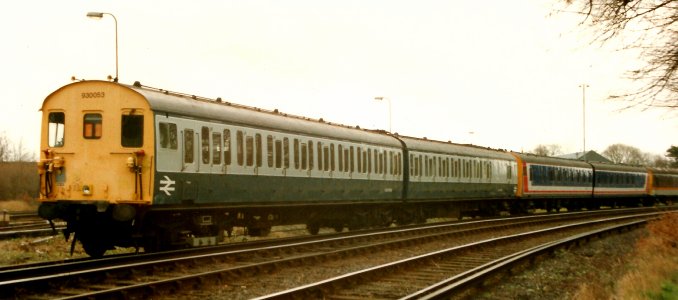
Railtrack had inspected 053 during mid 1996 and decided it was surplus to requirements and put it up for disposal. The rescue bid was on. The bidding process was handled by the British Rail procurement department at Derby and during the summer of 1996 a price was agreed with them that was just above the scrap value and also included the cost of rail movement to Wimbledon Park where it could be collected and transported to a new home at the Rother Valley Railway at Robertsbridge. It remained here for three years and then moved to the Coventry Railway Centre. When the Electric Railway Museum closed in 2017 arrangements were made to move it to a new home and the good people at the Battlefield Railway offered one, the unit moving there in May 2018. Restoration work will commence in 2021.
